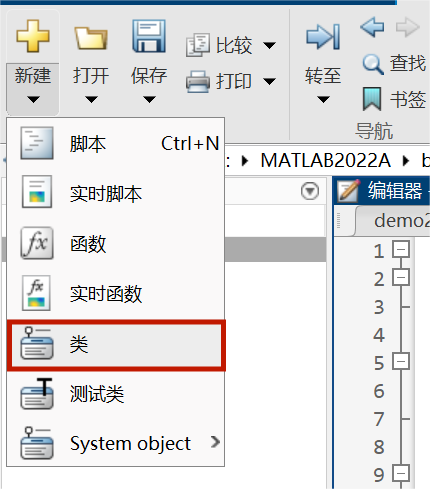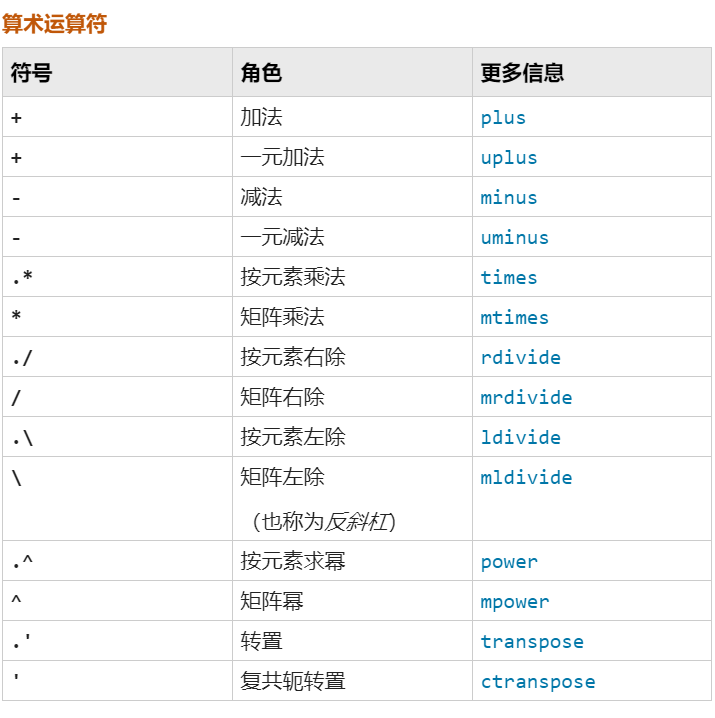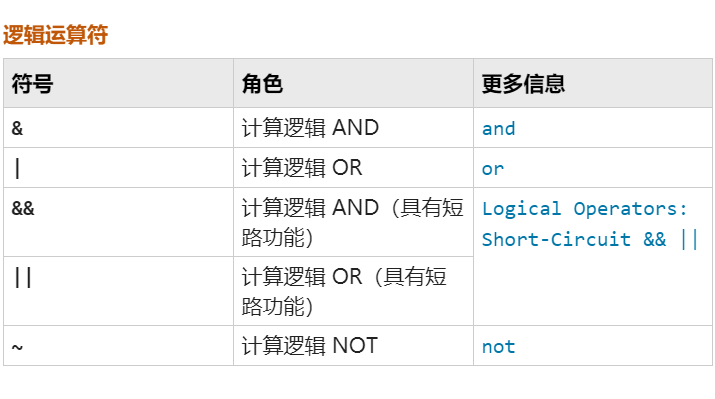很多人发现我的很多绘图函数都写成了类哈,这一期讲讲MATLAB面向对象编程基础知识之《类的创建及运算符的重载》。
首先点击图示位置创建类:

classdef untitled %UNTITLED 此处提供此类的摘要 % 此处提供详细说明
properties Property1 end
methods
function obj = untitled(inputArg1,inputArg2) %UNTITLED 构造此类的实例 % 此处提供详细说明 obj.Property1 = inputArg1 + inputArg2; end
function outputArg = method1(obj,inputArg) %METHOD1 此处提供此方法的摘要 % 此处提供详细说明
outputArg = obj.Property1 + inputArg; end
end
end
我们看到自动生成的文件具有properties属性,methods方法等组成部分,对于基础的类有这俩部分已经足够了更复杂的类还会有比如events事件等一系列组成部分,
复数类与基础知识讲解 属性与构造函数这里我们今天做示范就讲解一下如何建立一个复数类,复数类要包含实部和虚部两个属性,我们将这个自动生成的类进行一下改写,改成输入实部虚部两个参数创建新的对象,并将这两个属性分别存到对象的real和imag属性:
classdef complexS
properties
real,imag
end
methods
function obj=complexS(real,imag) obj.real=real; obj.imag=imag; end
end
end
这样我们就可以通过如下方式创建复数:
a=complexS(3,4)
a = complexS - 属性: real: 3 imag: 4
类的方法我们定义一个名为sum的方法函数,实现实部加实部,虚部加虚部:
classdef complexS
properties
real,imag
end
methods
function obj=complexS(real,imag) obj.real=real; obj.imag=imag; end
function obj=sum(obj,arg) obj.real=obj.real+arg.real; obj.imag=obj.imag+arg.imag; end
end
end
这样我们就可以通过sum实现俩复数的加法:
a=complexS(3,4); b=complexS(1,-2); c=sum(a,b)
c = complexS - 属性: real: 4 imag: 2
运算符的重载但是sum(a,b)的形式太麻烦,我们有没有办法直接a+b就直接进行加法呢?MATLAB运算符的重载不像是C++的operater+的形式,它是直接每个运算符有专门的名字,例如算符+的名称为plus,将类改写:
classdef complexS
properties
real,imag
end
methods
function obj=complexS(real,imag) obj.real=real; obj.imag=imag; end
function obj=plus(obj,arg) obj.real=obj.real+arg.real; obj.imag=obj.imag+arg.imag; end
end
end
运行一下加法:
a=complexS(3,4); b=complexS(1,-2); c=a+b
c = complexS - 属性: real: 4 imag: 2
给一下常见运算符的名称:



当然还有一些比如@,:等运算符,详细信息请参见: https://ww2.mathworks.cn/help/matlab/matlab_prog/matlab-operators-and-special-characters.html?s_tid=srchtitle_operator_5
单目运算符有了上面的写法和思路,我们非常容易能使用minus定义出减法,但是这样的减法必须两个复数做减法,我只想把a变成-a咋办呢?我们注意到上面表里还有个叫做一元减法的玩意uminus这个能够实现相反数功能:
classdef complexS
properties
real,imag
end
methods
function obj=complexS(real,imag) obj.real=real; obj.imag=imag; end % 加法
function obj=plus(obj,arg) obj.real=obj.real+arg.real; obj.imag=obj.imag+arg.imag; end % 减法
function obj=minus(obj,arg) obj.real=obj.real-arg.real; obj.imag=obj.imag-arg.imag; end % 一元减法
function obj=uminus(obj) obj.real=-obj.real; obj.imag=-obj.imag; end
end
end
试试正常减法和一元减法:
a=complexS(3,4); b=complexS(1,-2); a-b -a
ans = complexS - 属性: real: 2 imag: 6 ans = complexS - 属性: real: -3 imag: -4
输入参数类型我们有时候只想在右侧加个实数,而不一定加个复数咋办,我们可以在编写函数的时候用isa判断一下输入变量的类型再做出不同的处理,比如把之前的加法函数改为:
% 加法 function obj=plus(obj,arg) if isa(arg,'double') obj.real=obj.real+arg; else obj.real=obj.real+arg.real; obj.imag=obj.imag+arg.imag; end end
a=complexS(3,4); b=complexS(1,-2); a+1
ans = complexS - 属性: real: 4 imag: 4
输出函数的重载我们每次运行完的结果显示都是
ans = complexS - 属性: real: 4 imag: 4
这种形式,我们怎么能很简洁的显示x+yi这种格式呢?想不到吧disp这个函数也能重载,将类改为如下形式:
classdef complexS
properties
real,imag
end
methods
function obj=complexS(real,imag) obj.real=real; obj.imag=imag; end % 显示
function disp(obj) if obj.real==0 switch true case obj.imag==0,fprintf('%s','0'); case obj.imag>0,fprintf('%s',[num2str(obj.imag),'i']); case obj.imag<0,fprintf('%s',[num2str(obj.imag),'i']); end else fprintf('%s',num2str(obj.real)) switch true case obj.imag==0 case obj.imag>0,fprintf('%s',['+',num2str(obj.imag),'i']); case obj.imag<0,fprintf('%s',[num2str(obj.imag),'i']); end
end fprintf('\n'); end % 加法
function obj=plus(obj,arg) if isa(arg,'double') obj.real=obj.real+arg; else obj.real=obj.real+arg.real; obj.imag=obj.imag+arg.imag; end
end % 减法
function obj=minus(obj,arg) if isa(arg,'double') obj.real=obj.real-arg; else obj.real=obj.real-arg.real; obj.imag=obj.imag-arg.imag; end
end % 一元减法
function obj=uminus(obj) obj.real=-obj.real; obj.imag=-obj.imag; end
end
end
这样不管是不加分号还是disp都是正常的复数:
disp(complexS(3,-4)) complexS(-1,-4)
3-4i ans = -1-4i
完整复数类一个支持四则运算及一些简单运算的复数类,此例子只用于简单的类练习:
classdef complexS
properties
real,imag
end
methods
function obj=complexS(real,imag) obj.real=real; obj.imag=imag; end % 显示
function disp(obj) if obj.real==0 switch true case obj.imag==0,fprintf('%s','0'); case obj.imag>0,fprintf('%s',[num2str(obj.imag),'i']); case obj.imag<0,fprintf('%s',[num2str(obj.imag),'i']); end else fprintf('%s',num2str(obj.real)) switch true case obj.imag==0 case obj.imag>0,fprintf('%s',['+',num2str(obj.imag),'i']); case obj.imag<0,fprintf('%s',[num2str(obj.imag),'i']); end
end fprintf('\n'); end % 加法
function obj=plus(obj,arg) if isa(arg,'double') obj.real=obj.real+arg; else obj.real=obj.real+arg.real; obj.imag=obj.imag+arg.imag; end
end % 减法
function obj=minus(obj,arg) if isa(arg,'double') obj.real=obj.real-arg; else obj.real=obj.real-arg.real; obj.imag=obj.imag-arg.imag; end
end % 一元减法
function obj=uminus(obj) obj.real=-obj.real; obj.imag=-obj.imag; end % 乘法
function obj=mtimes(obj,arg) if isa(arg,'double') obj.real=obj.real.*arg; obj.imag=obj.imag.*arg; else [obj.real,obj.imag]=... deal(obj.real*arg.real-obj.imag*arg.imag,... obj.real*arg.imag+obj.imag*arg.real); end
end % 除法
function obj=mrdivide(obj,arg) if isa(arg,'double') obj.real=obj.real./arg; obj.imag=obj.imag./arg; else [obj.real,obj.imag]=... deal(obj.real*arg.real+obj.imag*arg.imag,... -obj.real*arg.imag+obj.imag*arg.real); obj.real=obj.real./(arg.real.^2+arg.imag.^2); obj.imag=obj.imag./(arg.real.^2+arg.imag.^2); end
end % 共轭
function obj=conj(obj) obj.imag=-obj.imag; end % 模长
function normval=norm(obj) normval=norm([obj.real,obj.imag]); end
end
end
调用:
fprintf('\n创建:a=') a=complexS(3,4); disp(a) fprintf('\n创建:b=') b=complexS(1,-2); disp(b) fprintf('\n加法:a+b=') disp(a+b) fprintf('\n减法:a-b=') disp(a-b) fprintf('\n乘法:a*b=') disp(a*b) fprintf('\n除法:a/b=') disp(a/b) fprintf('\n共轭:conj(a)=') disp(conj(a)) fprintf('\n模长:||a||=') disp(norm(a))
创建:a=3+4i
创建:b=1-2i
加法:a+b=4+2i
减法:a-b=2+6i
乘法:a*b=11-2i
除法:a/b=-1+2i
共轭:conj(a)=3-4i
模长:||a||= 5
小作业:多项式类请创建多项式类并具有基本的加减乘带余除法,积分求导等功能:
示例代码:
classdef polynom
properties
coe
end
methods
function obj=polynom(coe) obj.coe=coe; end % ========================================================================= % 输出 -------------------------------------------------------------------- function disp(obj) if all(obj.coe==0) disp('0') else baseStr=char(32.*ones([1,length(obj.coe)*10])); for i=1:length(obj.coe) tStr=''; if obj.coe(i)~=0 if obj.coe(i)>0 oStr='+'; else oStr=''; end
nStr=num2str(obj.coe(i)); if i~=length(obj.coe) if str2double(nStr)==1,nStr='';end if str2double(nStr)==-1,nStr='-';end
end if i==(length(obj.coe)-1) tStr=[oStr,nStr,'x']; else tStr=[oStr,nStr,'x^',num2str(length(obj.coe)-i)]; end
end
ind=find(abs(baseStr)==32,1); baseStr(ind:ind+length(tStr)-1)=tStr; end baseStr(abs(baseStr)==32)=[]; if strcmp(baseStr(end-2:end),'x^0'),baseStr(end-2:end)=[];end if strcmp(baseStr(1),'+'),baseStr(1)=[];end disp(baseStr) end
end % 加法 -------------------------------------------------------------------- function obj=plus(obj,arg) if isa(arg,'double') tcoe=arg; else tcoe=arg.coe; end
L1=length(obj.coe); L2=length(tcoe); baseCoe=zeros([1,max(L1,L2)+1]); baseCoe(end+1-L1:end)=baseCoe(end+1-L1:end)+obj.coe; baseCoe(end+1-L2:end)=baseCoe(end+1-L2:end)+tcoe; obj.coe=baseCoe(find(baseCoe~=0,1):end); end % 减法 -------------------------------------------------------------------- function obj=minus(obj,arg) if isa(arg,'double') tcoe=arg; else tcoe=arg.coe; end
L1=length(obj.coe); L2=length(tcoe); baseCoe=zeros([1,max(L1,L2)+1]); baseCoe(end+1-L1:end)=baseCoe(end+1-L1:end)+obj.coe; baseCoe(end+1-L2:end)=baseCoe(end+1-L2:end)-tcoe; obj.coe=baseCoe(find(baseCoe~=0,1):end); end
function obj=uminus(obj) obj.coe=-obj.coe; end % 乘法 -------------------------------------------------------------------- function obj=mtimes(obj,arg) L1=length(obj.coe); L2=length(arg.coe); tmat=zeros(L2,L1+L2-1); for i=1:L2 tmat(i,i:(i+L1-1))=arg.coe(i).*obj.coe; end
obj.coe=sum(tmat); end % 带余除法 ----------------------------------------------------------------- function [obj1,obj2]=mrdivide(obj,arg) L1=length(obj.coe); L2=length(arg.coe); tCoe=obj.coe; obj1=polynom(0); for i=1:(L1+1-L2) obj1.coe(i)=1./(arg.coe(1)).*(tCoe(1)); tCoe(1:L2)=tCoe(1:L2)-arg.coe.*obj1.coe(i); tCoe(1)=[]; end
obj2=polynom(tCoe); end % 数值计算 ----------------------------------------------------------------- function value=val(obj,x) value=x.^(length(obj.coe)-1:-1:0)*(obj.coe.'); end % 积分 -------------------------------------------------------------------- function output=int(obj,a,b) if nargin<2 output=polynom([obj.coe./(length(obj.coe):-1:1),0]); else tcoe=[obj.coe./(length(obj.coe):-1:1),0]; output=b.^(length(tcoe)-1:-1:0)*(tcoe.')-... a.^(length(tcoe)-1:-1:0)*(tcoe.'); end
end % 求导 -------------------------------------------------------------------- function obj=diff(obj) obj.coe=obj.coe.*(length(obj.coe)-1:-1:0); obj.coe(end)=[]; end % 比较 -------------------------------------------------------------------- function bool=eq(obj,arg) if length(obj.coe)~=length(arg.coe) bool=false; else bool=all(obj.coe==arg.coe); end
end
function bool=ne(obj,arg) if length(obj.coe)~=length(arg.coe) bool=true; else bool=~all(obj.coe==arg.coe); end
end
end
end
fprintf('\n创建:a(x)=') a=polynom([3,4,1,0]); disp(a) fprintf('\n创建:b(x)=') b=polynom([3,2]); disp(b) fprintf('\n加法:a(x)+b(x)=') disp(a+b) fprintf('\n加法:a(x)+5x+6=') disp(a+[5,6]) fprintf('\n减法:a(x)-b(x)=') disp(a-b) fprintf('\n相反数:-a(x)=') disp(-a) fprintf('\n乘法:a(x)*b(x)=') disp(a*b) fprintf('\n除法:a(x)/b(x)') [c,d]=a/b; fprintf('\n商=') disp(c) fprintf('余数=') disp(d) fprintf('\n积分:int(a(x))=') disp(int(a)) fprintf('\n求导:diff(a(x))=') disp(diff(a)) fprintf('\n数值计算:a(5)=') disp(val(a,5)) fprintf('数值积分:int(a(x),0,1)=') disp(int(a,0,1)) fprintf('比较:a(x)==b(x)=') disp(a==b) fprintf('比较:a(x)~=b(x)=') disp(a~=b)
创建:a(x)=3x3+4x2+x
创建:b(x)=3x+2
加法:a(x)+b(x)=3x3+4x2+4x+2
加法:a(x)+5x+6=3x3+4x2+6x+6
减法:a(x)-b(x)=3x3+4x2-2x-2
相反数:-a(x)=-3x3-4x2-x
乘法:a(x)*b(x)=9x4+18x3+11x^2+2x
除法:a(x)/b(x) 商=x^2+0.66667x-0.11111 余数=0.22222
积分:int(a(x))=0.75x4+1.3333x3+0.5x^2
求导:diff(a(x))=9x^2+8x+1
数值计算:a(5)= 480
数值积分:int(a(x),0,1)= 2.5833
比较:a(x)==b(x)= 0
比较:a(x)~=b(x)= 1



